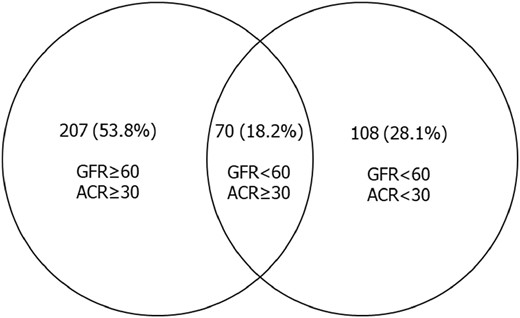-
PDF
- Split View
-
Views
-
Cite
Cite
Mustafa Arici, Kenan Ateş, Alaattin Yildiz, Ali Riza Odabas, Bulent Tokgoz, Siren Sezer, Halil Zeki Tonbul, Bulent Altun, #5047 DIABETES AND CHRONIC KIDNEY DISEASE IN TURKEY (DIAKIT): THE STUDY ON CHRONIC KIDNEY DISEASE IN DIABETES MELLITUS PATIENTS IN THE CAPPADOCIA COHORT, Nephrology Dialysis Transplantation, Volume 38, Issue Supplement_1, June 2023, gfad063d_5047, https://doi.org/10.1093/ndt/gfad063d_5047
Close - Share Icon Share
Abstract
Diabetes mellitus (DM) is the most common cause of chronic kidney disease (CKD) [1]. The prevalence of CKD is therefore increasing worldwide with increasing prevalence of DM [1]. Among those with DM, CKD prevalence varies widely between countries. The actual prevalence of CKD in patients with DM in Turkey is unknown. This study aimed to determine frequency of CKD among diabetic patients of Cappadocia cohort and patients’ awareness about the disease.
A total of 1591 diabetic patients from the Cappadocia cohort were invited to this cross-sectional study. A trained study team administered a questionnaire for patients’ medical history, knowledge, attitudes, and awareness of the disease and measured patients’ blood pressures (BPs) at least three times using an automated device. Serum creatinine was measured and spot urine albumin/creatinine ratio (ACR) measurements were performed for three consecutive days. A diagnosis of CKD was established if glomerular filtration rate (GFR)is <60 mL/min or ACR is >30 mg/g.
The mean age of the patients was 63±10 years. Overall, 60.9% patients were obese (body mass index ≥30 kg/m2), and 70% patients were hypertensive. HbA1c was analyzed in 98.2% of the patients; HbA1c was <7% in 27.4%, ≥7%-≤8% in 20.8%, >8%-≤9% in 17.7%, and >9% in 34.1% of the patients. of 1535 patients with blood and urine analyses, 231 of 1008 (22.9%) females and 154 of 527 (29.2%) males had CKD (P = .007). Among patients with GFR values, 11.4% had a GFR of <60 mL/min and 88.6% had a GFR of ≥60 mL/min. Among 1544 patients with ACR measurements, 18.2% had values ≥30 mg/g and 4.4% had values ≥300 mg/g. CKD was detected in 385 (25.1%) of 1535 patients with both GFR and ACR values (Figure 1). of these patients, 28.1% had Stage 1, 25.7% had Stage 2, 32.5% had Stage 3A, 11.2% had Stage 3B and 2.6% had Stage 4 or 5 CKD. Excluding two patients with missing data, 36 of 383 CKD patients (9.4%) knew that they had CKD. In the logistic regression analysis, old age (OR=1.05, 95% CI 1.03-1.07; p<0.001), male sex (OR=2.11, 95% CI 1.43-3.12; p<0.001), duration of DM (OR=1.03, 95% CI 1.00-1.05; P = .022), morbid obesity (OR=3.58, 95% CI 1.28-10.03, P = .015), a CRP level of >5 mg/L (OR=1.60, 95% CI 1.12-2.27; P = .009), a triglyceride level of ≥150 mg/L (OR=1.74, 95% CI 1.24-2.45; P = .002), and grade 3 hypertension (OR=2.13, 95% CI 1.02-4.44; P = .043) were found to be significantly associated with an increased risk of CKD in patients with DM.
In the present study, CKD prevalence among diabetic patients in Turkey was 25.1%. Overall, 53.8% of the patients with CKD had a GFR of ≥60 mL/min although they had an ACR of ≥30 mg/day; that is, if albuminuria was not studied, this subgroup of patients would have been considered to have normal kidney function according to GFR. The awareness of CKD was found to be quite low in the patients. Therefore, periodic screening of diabetic patients should always include urinalysis, particularly ACR, as well as serum creatinine, fasting blood glucose and HbA1c.

Glomerular filtration rate (GFR) and albumin-to-creatinine ratio (ACR) among diabetic patients with chronic kidney disease.
REFERENCE
- obesity
- hypertension
- triglycerides
- body mass index procedure
- diabetes mellitus
- renal function
- albumins
- kidney failure, chronic
- blood pressure
- creatinine
- glomerular filtration rate
- attitude
- hemoglobin a, glycosylated
- obesity, morbid
- urinalysis
- fasting blood glucose measurement
- diagnosis
- medical history
- urine
- older adult
- creatinine tests, serum
- medical devices
- albuminuria
- missing data





Comments